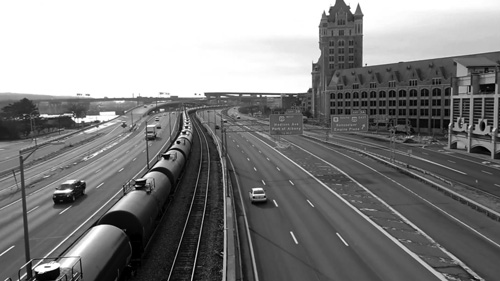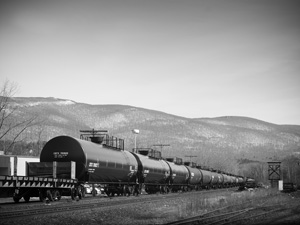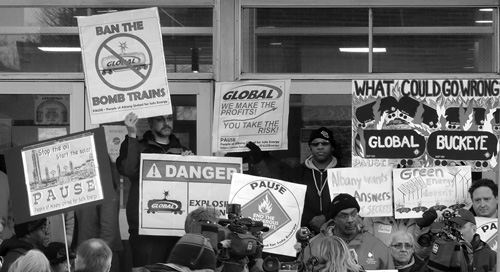News
Oil pipelines on wheels
Risks increase on region’s rail lines as traffic through Albany port grows
By TRACY FRISCH
Contributing writer


While environmental groups have made opposition to the Keystone XL pipeline in the Midwest a cause célèbre over the past five years, rolling pipelines of oil have quietly been established in a lot of communities closer to home.
Across eastern New York and western New England, mile-long freight trains now carry a veritable ocean of highly flammable crude oil from the Bakken shale region of North Dakota through local towns and cities as the fuel makes its way to refineries along the East Coast. A typical “unit train” of 100 tank cars carries about 3 million gallons of crude oil.
Many of the trains – the number of which has increased dramatically in just the past two years – snake their way along the western shore of Lake Champlain, then through Fort Edward and Saratoga Springs, on their way south from Montreal. Others slam past Amtrak trains on the busy line from Buffalo to Albany.
Some oil trains continue south along the west shore of the Hudson River, en route to a refinery in New Jersey. Others roll east into New England – through Mechanicville, Hoosick Falls, Pownal, Williamstown and North Adams – on their way to a refinery in New Brunswick.
Much of the oil-by-rail traffic in the region is bound for the Port of Albany, where local opponents have launched a campaign in recent months to demand tougher scrutiny of the trains’ safety -- and to block further expansion of oil shipments and processing at the Hudson River port. At rallies and public forums, the opponents carry signs with an incendiary slogan to match the trains’ cargo: “Ban the bomb trains.”
Although standard crude oil is heavy and not particularly flammable, crude from the Bakken shale region is much lighter and may contain gases like propane that make it highly volatile.
The explosive nature of the Bakken crude – and the risks of transporting it by rail – were revealed dramatically and tragically in July, when a runaway train careened into the town of Lac-Megantic, Quebec, 20 miles from the Maine border. Some of the train’s tank cars ruptured and exploded, setting off an inferno that killed 47 people and leveled much of the historic downtown in the community of 6,000. The blaze, which took firefighters more than 30 hours to contain, burned so hot that investigators believe the bodies of five missing people were volatilized.
Before the Lac-Megantic disaster, most people were unaware of the sharp increase in crude-oil rail shipments in recent years. And since then, the railroad industry and its regulators in the United States and Canada have been slow to pursue changes that could make the trains safer.
“It’s shocking to me that we’ve had this big change in energy transportation in such a short time -- basically without any public discussion until trains started blowing up and people dying,” said Mollie Matteson, a senior scientist at the Center for Biological Diversity in Vermont. Her organization recently sued the U.S. Coast Guard and the Environmental Protection Agency over what it contends are inadequate oil spill response plans for the Hudson River and New York Harbor.
New hub for oil: Albany
Beginning as a trickle in late 2011, the flow of oil-by-rail shipments through the region has transformed the sleepy inland Port of Albany into one of the most important North American crude-oil rail and shipping hubs. At the port, much of the crude is unloaded into storage tanks and then transferred to barges and ocean-going tanker ships. Critics say the cargo transfers add to the risk of a spill or explosion.
The two companies that ship crude oil through their terminals at the Albany port -- Global Partners of Waltham, Mass., and Buckeye Partners of Houston, Texas -- have state permits allowing them to handle up to 2.8 billion gallons (or about 67 million barrels) annually.
Within the past 18 months, the state Department of Environmental Conservation state allowed both companies to more than double the upper limit in their permits without requiring a full environmental impact statement or any public scrutiny. Instead, DEC staff relied on assurances from the companies that the expansion posed no added risk.
But a coalition of Albany-area residents and elected officials and state and national environmental groups is now pushing the DEC to rescind its approval of the new permit limits and undertake of full environmental review of that issue as well as Global Partners’ request to install several boilers that could be used to heat heavier forms of crude oil at its Albany terminal.
In late March, the DEC informed Global Partners that it is reviewing the case and that it considers its finding that the project doesn’t require a full review to be an “interim” determination. The department also asked the company for a host of additional information about its operations.
Opponents are concerned that if Global Partners’ plans go forward, oil shipping through Albany could expand to include risks beyond those of the Bakken-crude trains, because the heaters would allow the port to begin handling crude oil from the tar sands of western Canada – a source widely condemned as one of the world’s dirtiest energy sources and one with the biggest climate-change footprint.
The Albany area already is on the receiving end of nearly one-fifth of all the crude oil being produced in the Bakken shale region. That’s a large and growing figure: The Bakken oil boom has catapulted North Dakota to No. 2 in the nation, behind only Texas, in oil output. As of December, the Bakken region of North Dakota and eastern Montana was producing more than 1 million barrels of oil a day, or better than 10 percent of all domestic oil production, according to the U.S. Energy Information Administration. (The Bakken oil deposits also extend north into the Canadian provinces of Saskatchewan and Manitoba.)
Given that there’s only one north-south pipeline with limited capacity serving the Bakken area, three-quarters of the oil produced there is shipped out by rail. The crude oil is destined for refineries on the East and West coasts, where it’s displacing more expensive foreign imports. (Since the oil crisis of the early 1970s, domestic oil producers have not been allowed to export, except to Canada.)
Public safety at issue
A spike in accidents has accompanied the remarkable national increase of crude oil shipments by rail. In 2013, a record 1.15 million gallons of crude oil leaked and spilled from railroad tank cars in the United States, according to federal statistics. That’s considerably more than the total spilled in the nearly 40 previous years since the federal government began collecting data.
The frequency of derailments has also picked up. An oil train derailed in November in western Alabama, setting off an explosion and fire and contaminating a wetlands area. And on Dec. 30, a 106-car oil train collided with a derailed grain train near Casselton, N.D., and 18 tank cars exploded; the surrounding area was evacuated as the resulting fire burned for two days.
Since December, CSX, one of two railroads that carry crude oil through Albany, has had four derailments involving oil trains in New York. Although none of these resulted in a spill or fire, critics say the incidents should serve as wake-up calls.
Tim Truscott, a retired anatomy instructor from a local medical college, was one of the first people in Albany to begin raising questions about the safety of crude-oil trains moving through the city – and to begin pressing for stronger safeguards.
As the trains approach the Port of Albany, they pass within 50 feet of the Ezra Prentice Homes, where 180 low-income families live, and a day care center. Long lines of tank cars also can often be seen sitting parked along a rail line that runs down the median of Interstate 787 in downtown Albany as they wait to get access to the port.
But some state and local officials have been slow to acknowledge the potential hazards.
To find out about the public safety risks, Truscott said he drew on the expertise of Fred Millar, a Virginia-based hazardous materials transportation safety consultant. In October, he said, Millar called Harry Merriman, the chairman of the Albany County Local Emergency Planning Committee. Asked about the emergency plans for an oil train accident, Merriman indicated he was unaware of the trains’ existence, Truscott said. Later, after Merriman’s committee met with officials from Global Partners, he assured a Times Union reporter that the oil trains are “safer than your car in your driveway.”
Last summer, Truscott found an early ally in Albany Common Council member Dominick Calsolaro. With Calsolaro bringing the issue to the attention of his fellow council members, by the end of last year the council had passed two resolutions of concern about oil trains.
Later, citizens and elected officials from low-income and minority neighborhoods near the path of the trains demanded that the DEC require an environmental impact statement and an environmental justice outreach plan regarding crude-oil transportation through Albany.
Truscott and other critics of the oil trains banded together in January to form People of Albany United for Safe Energy, or PAUSE, to slow down or stop the flow of oil through Albany. The group has pointed to accidents involving Bakken oil trains while also warning of the hazards that would set in motion if the port starts handling tar-sands crude.
Will tar-sands oil be next?
Concerns about crude-oil shipments through Albany intensified this winter after opponents learned that Global Partners, one of the two companies that handle crude oil at the Albany port, has proposed installing multiple heating units at its terminal to allow the unloading of heavier grades of crude oil from rail cars.
Although Global Partners hasn’t told the state environmental agency what type of crude oil its proposed boilers would heat, there is little doubt that it would be tar-sands crude, which is very thick and heavy.
Not much tar-sands oil is being transported by rail yet, in part because ports of discharge must have a heating apparatus like the one Global is proposing to liquefy the crude oil enough for pumping.
According to “All Oiled Up,” an article in the March issue of Trains magazine, Canada’s tar-sands industry has only started to believe in the past six months that shipping by rail is cheaper than using pipelines. North Dakota oil producers, in contrast, have been using trains for three years.
Compared with pipelines, shipping by rail provides considerably more flexibility. Oil companies also have reason to shy away from long-term, put-or-pay pipeline contracts that they won’t be able to fulfill if production plummets or their customers change.
It also takes years to plan and build a pipeline, and public opposition can delay construction significantly, as it has with the Keystone XL project and the proposed Constitution natural-gas pipeline that would run from northeastern Pennsylvania to Schoharie County, N.Y.
And tar-sands crude must be diluted much more to flow through a pipeline than to be carried in a railcar, resulting in additional expense.
The only thing that now prevents Global Partners from bringing tar-sands crude oil into Albany by rail and shipping it down the Hudson River by boat is a lack of regulatory approval to install the four steam boilers and three heaters it has proposed.
Spill risks, climate-change concerns
Unlike Bakken crude oil, tar-sands crude isn’t explosive or even flammable. But it’s heavy and sticky and, being nearly solid, it sinks in water. Environmentalists warn that this makes tar-sands crude nearly impossible to clean up if it spills.
That risk has already been demonstrated along the Kalamazoo River in Michigan, where 31,000 barrels of tar-sands crude leaked out of a pipeline in 2010. The Kalamazoo remains contaminated from the spill, despite the expenditure of nearly $800 million so far on a cleanup effort that included dredging oil-laden sediment from a 35-mile stretch of the river. The Canadian company that operates the pipeline has paid for the cleanup work so far and was also fined $3.7 million by federal investigators who concluded the spill was made worse by the company’s bumbling response when the pipeline began leaking.
Apart from the spill risk, tar-sands oil has long been controversial because of the environmental devastation caused by its production. Much of the oil is obtained through strip mining, which has led to the destruction of vast expanses of boreal forest in western Canada. Once removed from the ground, the tar sands must be heated to extract a heavy tar-like substance called bitumen and leaving behind mounds of hazardous waste.
Widespread development of tar-sands oil was for many years considered too costly to pursue, but the sharp increase in oil prices in recent years has made the Canadian tar sands cost-competitive.
But environmentalists say tar-sands oil, because of the large energy inputs required to produce it, is a far bigger contributor to climate change than other forms of crude oil.
Christopher Amato, a lawyer for the environmental group EarthJustice, sees the court fight over Global Partners’ proposed boilers as part of a larger struggle.
“We have an opportunity to stop our own virtual Keystone XL pipeline,” Amato declared in March at the monthly dinner meeting of the local environmental group Save the Pine Bush. His organization is among those trying to compel the DEC to conduct a full environmental review of crude-oil shipments through the Albany port.
Amato, who served as the DEC’s assistant commissioner for natural resources from 2007-11, said the agency has repeatedly declared that it’s not interested in knowing the source of the crude oil flowing through the port. He said he finds that position “very puzzling.”
Communities seek a voice
The area along the New York-New England border has so far been somewhat removed from the heated debates in recent years over hydraulic fracturing and tar-sands oil development. The region has no known fossil-fuel reserves.
But thanks to the network of railroad corridors feeding the port of Albany, lots of communities around the region are fast becoming part of the chain of new production of domestic fossil fuels.
The railroads are regulated by the federal government and are largely exempt from any state or local efforts to restrict their shipments. And as common carriers, freight railroads say they don’t have the right to reject any legally permissible cargo a shipper asks them to transport.
But some local governments are targeting other links in the transportation chain.
The city council in South Portland, Maine, for example, voted in December to impose a six-month moratorium on approving any project or development that includes loading tar sands onto ships in the city. The council appears poised to renew the moratorium while a committee finishes crafting a permanent ordinance. The city, it seems, is trying to do an end-run around the South Portland Pipeline Co.’s proposal to reverse the direction of its pipeline to Montreal – a proposal that would allow the pipeline to carry tar-sands oil from Canada to the Maine port.
In Albany, County Executive Daniel McCoy issued an order March 12 blocking construction of any crude-oil heating infrastructure until the completion of a public health study. A representative of Global Partners responded by claiming the county had no authority to impose such an order.
A few days after McCoy’s order, Albany Mayor Kathy Sheehan asked the city planning board to act independently of the state environmental agency and require Global Partners to do a full environmental impact statement before acting on its application.
Over that weekend, Global Partners decided to change its plans. It shifted the location of the proposed boilers to an existing building it owns in Albany’s port district, which is under the jurisdiction of a state authority, rather than the city.
Regulators slow to act
Susan Christopherson, an economic development expert with Cornell University’s Department of City and Regional Planning, got interested in the issue of oil trains when she received a small state grant to study the Port of Albany. She said she was astonished to discover, from the port’s commodity logs, the recent steep increase in crude oil shipments.
As she began to assess the risks involved in the new influx of oil to the port, Christopherson said she soon learned that railroad safety falls under the jurisdiction of the Federal Railroad Administration, an agency that has so few staff and resources that it is only able inspect about 1 percent of the nation’s railroad infrastructure each year.
“The regulatory system is simply not up to dealing with the surge of activity, especially with the hazardous materials,” Christopherson said.
Similarly, in announcing the Center for Biological Diversity’s lawsuit over oil spill cleanup plans, Matteson faulted what she characterized as the federal government’s “continued foot-dragging and hollow incremental measures” on oil-train safety.
What would make the trains safer?
Normally crude oil cannot be readily ignited, but crude oil from the Bakken shale region of North Dakota is lighter and may contain highly volatile gases. An analysis by The Oregonian newspaper found that Bakken crude moving by train through that state contained six times more propane than similar types of crude oil. And in February, The Wall Street Journal reported that Bakken crude had the highest vapor pressure in tests of 86 crude oils of various origins.
Former oil industry insiders and regulators say producers could remove dangerous concentrations of combustible gases in Bakken crude by flaring or other methods prior to shipping it.
But so far, federal regulators have restricted their concerns to accurate labeling of tank cars. They have done spot inspections to ensure that the warning numbers on the hazardous materials placards on each car are consistent with the cargo’s actual flammability and explosiveness.
Puncture-prone tank cars
One key problem, however, is that many older tank cars were not designed to handle highly flammable materials like Bakken crude oil. The National Transportation Safety Board has been calling attention to the vulnerability of older, single-walled tank cars, known by the model number DOT-111, since 1991, but this model still accounts for more than two-thirds of the tanks cars in the United States – and more than 80 percent of the Canadian fleet. All of the cars that ruptured in the Lac-Megantic disaster were this type.
The industry adopted voluntary standards in 2011 to toughen the construction of newly built tank cars. Since then, 10,000 new tank cars have come off the assembly line, and thousands of older cars have been retrofitted to meet the new standards.
Although the newer cars are sturdier, they don’t meet the safety thresholds recommended by the NTSB. The U.S. Department of Transportation, despite calls for action, has put off proposing new regulations for tank car construction until next year.
Safety advocates and some railroad officials say the older, more vulnerable cars should be taken out of circulation as quickly as possible. But the cars generally are owned by shippers and leasing companies, not by the railroads. With more than 100,000 of the older DOT-111 models still in circulation, some industry officials estimate it could take as long as 10 years to replace them all.
Meanwhile, the unprecedented volume of oil moving by rail has kept the demand for tank cars so high that none of the older cars are being retired early. (Rail freight cars have a legal service life of 50 years.)
Critics contend the industry would be able to phase in the newer cars within two or three years if it had to.
One downside for the oil industry and the railroads is the safer tank cars weigh significantly more. Federal weight restriction for loaded railcars could mean the new cars would carry less oil. And not all tracks, bridges and trestles are strong enough to handle heavier loads.
Insuring against a catastrophe
The freight railroad whose runaway train caused the Lac-Megantic disaster, the Montreal, Maine & Atlantic Railway, filed for bankruptcy about a month after the derailment, and its assets were sold earlier this year to a new operator. At the time of the disaster, the short-line railroad had only $25 million in liability insurance. The environmental cleanup alone at Lac-Megantic is expected to cost $200 million – and that sum will easily be dwarfed by claims from victims’ families and from businesses destroyed in the inferno.
Unlike air and marine shipping companies, railroads in the U.S. and Canada are not allowed to require shippers to share in the liability for transporting hazardous cargo. This explains why shippers and tank cars companies are willing to continue using the older DOT-111 cars, even though the hazards of these cars are well known: The cars don’t pose any added liability risk to them.
In the months since the Lac-Megantic disaster, the Canadian Transportation Agency has been reviewing the adequacy of major railroads’ liability insurance. The news service Reuters reported that in submissions made as part of that review, major players in the industry acknowledged that it’s essentially impossible to insure against a catastrophic accident involving hazardous cargo.
Major railroads are unable to buy third-party coverage beyond about $1.5 billion in the insurance marketplace and generally must “self-insure” for amounts beyond that.
“Should an incident occur within or near a densely populated area,” the Association of American Railroads wrote in its submission to the Canadian agency, such an incident would have “the potential to be truly catastrophic and result in billions of dollars in personal injury and property damage claims. … The damages potentially resulting from an exposure could risk the financial soundness and viability of the rail transportation network in North America.”

